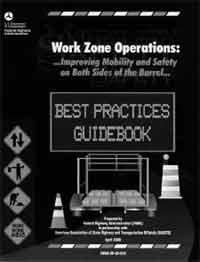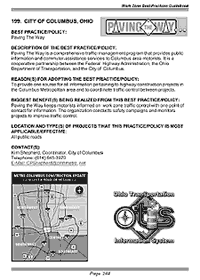Fact Sheet 6 - Work Zone Best Practices Guidebook
Winter/Spring 2001
 In
partnership with the American Association of State Highway and Transportation
Officials (AASHTO), the Federal Highway Administration (FHWA) recently
published a Work Zone Operations Best Practices Guidebook.The
Guidebook promotes the sharing of effective work zone technologies and
practices among practitioners across the nation. It is a reference document
of “state of the practice” technologies and approaches for
work zone mobility and safety management, and will be updated as the
state of the practice evolves. FHWA hopes that the information in the
Guidebook helps practitioners in making informed decisions and taking
actions that improve the operational efficiency and safety of the nation’s
highway system.
In
partnership with the American Association of State Highway and Transportation
Officials (AASHTO), the Federal Highway Administration (FHWA) recently
published a Work Zone Operations Best Practices Guidebook.The
Guidebook promotes the sharing of effective work zone technologies and
practices among practitioners across the nation. It is a reference document
of “state of the practice” technologies and approaches for
work zone mobility and safety management, and will be updated as the
state of the practice evolves. FHWA hopes that the information in the
Guidebook helps practitioners in making informed decisions and taking
actions that improve the operational efficiency and safety of the nation’s
highway system.
The Guidebook contains information on 262 work zone best practices identified through a 1998 scanning tour of 26 States. The best practices cover all aspects of roadway improvement planning, design, and construction. These practices were first recorded in the 1998 FHWA report Meeting the Customer’s Needs for Mobility and Safety During Construction and Maintenance Operations.The report organizes the practices into 11 major groupings of similar practices so that readers can find all of the practices that deal with a particular topic. The Guidebook takes this collection of work zone best practices and makes them more easily accessible by providing a series of cross references and a topical index that enables users to find best practices in several different ways.
Topics Covered in the Guidebook
Best practices are grouped into 11 major areas:
- Policies/procedures
- Prediction modeling and analysis
- Project development/design
- Enforcement
- ITS and innovation technology
- Evaluation and feedback
- Public relations/education/outreach
- Planning and programming
- Contracting and bidding
- Traveler and traffic information
- Specifications and construction materials, methods, and practices
For each major area, the Guidebook contains an assessment of the state of the art for work zone practice, a brief description of how transportation agencies can achieve the state of the art, a list of the best practices organized into more specific subcategories, and a description for each practice. The descriptions include:
- Reference number for the best practice (used in the cross-references section)
- Location where the best practice was observed
- Title for the best practice (used in the Meeting the Customer’s Needs report)
- Description of the practice/approach/technology
- Reason(s) for adopting the best practice
- Biggest benefit(s) being realized from the best practice
- Location and type(s) of projects where the best practice is most applicable/effective
- Point(s) of contact
The Guidebook contains a topical index with practices organized into 41 topics and subtopics and a series of cross-references. The cross-references enable practitioners to identify best practices based on where they were observed, project life-cycle stage, type of organization, geographic or demographic characteristics, nature of activity, traffic conditions, and type of roadway.
 “Best”
Practices
“Best”
Practices
The “best” practices listed in the Guidebook are descriptive, not prescriptive. That is, they describe approaches and technologies that some transportation agencies have used and found effective for achieving work zone mobility and safety. Each organization must determine which of the practices and technologies are best suited for its particular situation, considering all the factors that affect work zone operations. The Guidebook serves as a resource for State and local transportation agencies, construction contractors, transportation planners, trainers, and others with interest in work zone operations.
Receiving a Copy of the Guidebook
The Guidebook is available for download and printing on this Web Site. The Guidebook was also produced in print and CD-ROM formats. To obtain a copy of the CD-ROM, contact Mr. Phillip Ditzler at FHWA (Phillip.Ditzler@fhwa.dot.gov).
Guidebook Updates
This Guidebook is the first release of a “living” document that AASHTO and FHWA will work together to maintain and update. Future updates to the Guidebook will remove outdated practices and add new approaches, technologies, and practices as they become “state of the practice.” YOUR INPUT IS ESSENTIAL! We ask that you support this resource by identifying and documenting practices proven by your highway agency to improve mobility and safety in work zones. There is a best practices submission form in the Guidebook that can be mailed or faxed to FHWA. Users can also provide feedback on practices already in the Guidebook and on its overall usefulness through a comment form in the Guidebook. FHWA also encourages practitioners to complete and submit the registration form in the Guidebook so they can receive information on Guidebook updates.
To learn more, contact:
Mike Crow (AASHTO contact)
Kansas Department of Transportation
217 Southeast 4th Street, Floor 4
Topeka, KS 66603-3504
Phone: 785-296-3618
E-mail: mikec@ksdot.org
To share your Best Practices, contact:
Phillip Ditzler
Federal Highway Administration
400 Seventh Street, S.W.
Washington, DC 20590
Phone: 202-366-0855
Email: Phillip.Ditzler@fhwa.dot.gov
U.S. Department of Transportation
Federal Highway Administration
Publication No. FHWA-OP-01-009
